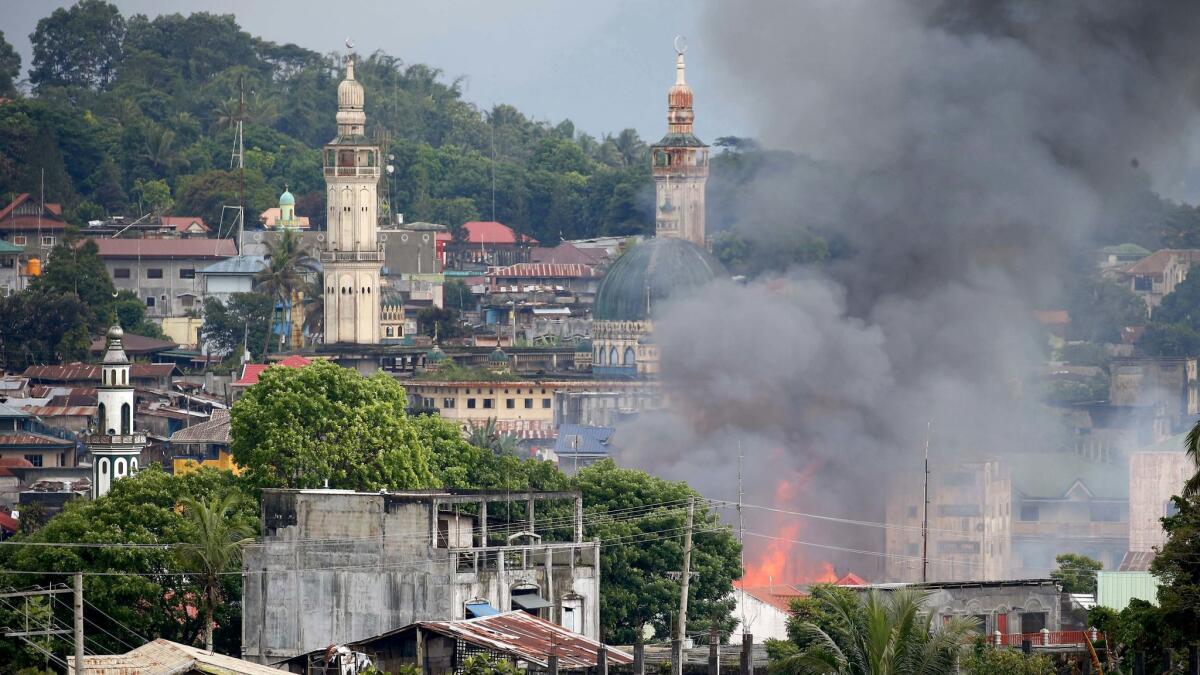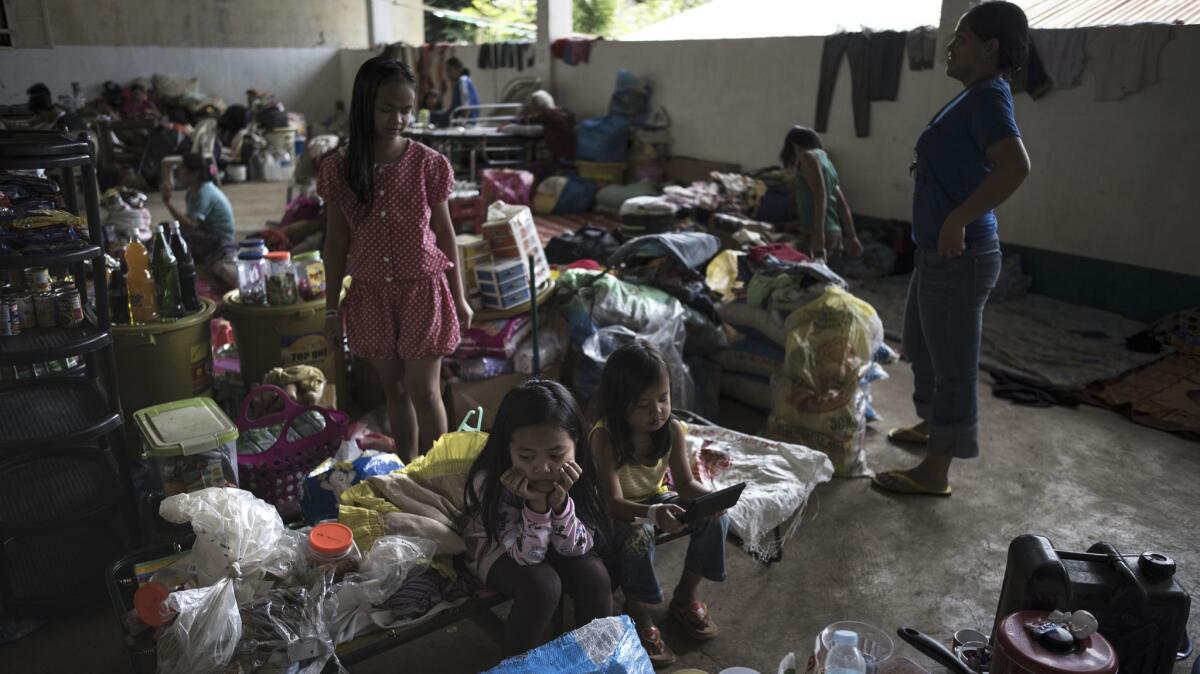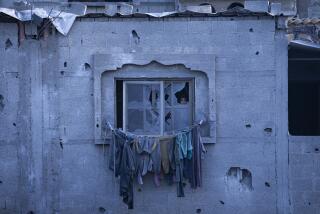Filipinos watch in horror as their city is destroyed in fight with Islamic State affiliate
- Share via
Reporting from MARAWI CITY, Philippines — Neither Noralyn Bangon nor her husband were home when the airstrikes began — fortunate for them, because their house was among the first hit.
“We paid for it with the combined sweat of our hard work — my husband from his work in local government, and me from my savings when I worked abroad as a nurse for 12 years,” she said wistfully weeks later.
In May, the Maute group, an Islamist militant organization affiliated with Islamic State, seized the city of Marawi in the southern Philippines, a region that has become a hot spot for militant groups. Now, from evacuation centers outside the city, thousands of evacuees such as Bangon helplessly wait while their homes are reduced to rubble, in many cases by government airstrikes.
They wonder what their lives, and their city, will be like when the battle is over.
Marawi is an overwhelmingly Muslim city in a predominantly Catholic country. It is on the southern island of Mindanao, where Muslims sought refuge centuries ago when the Philippines was under Spanish rule and its people were being forcibly converted to Catholicism.
“To this day, we have not given up our way of life, the way we dress and what we eat,” said Norhata Alonto, 67. In Marawi, minarets rather than spires stretch toward the sky, and pork — a staple in most of the country — is not openly sold.
The irony that the city has fallen to an Islamist extremist group is not lost on its people. “The Mautes … trampled on our pride and our history as a people that was never subjugated by a colonial power,” Alonto said.

It was days after the fighting began that Bangon, 52, first saw the full extent of the destruction in Marawi on the front page of a newspaper.
“I thought I was looking at Syria,” said a weeping Bangon, using a scarf she had tied around her head to wipe away her tears.
Government troops remain in fierce battle with the militants, employing air power almost every day to flush out fighters holed up in several corners of the city center.
More than 200,000 residents fled Marawi as armed men in black masks burned buildings, took civilians as hostages and killed Christians. Those who had the resources fled in vans and trucks, others who did not made it out on foot. Bangon holed up with relatives for several days, then fled.
An estimated 300 to 500 civilians remain trapped in the area held by the Maute group; the government says they are being used as human shields. The fierce battle has claimed the lives of more than 400 people.
It is unclear how many of the dead are civilians. But last week, the Philippine military recovered the mutilated bodies of 17 civilians while conducting clearing operations in one of the most pulverized parts of Marawi. The military blamed the militants for the deaths.
The fighting was sparked by a botched military operation to capture Isnilon Hapilon, listed as one of the world’s most-wanted terrorists with a $5-million bounty for his capture.
Military intelligence indicated that Hapilon had slipped into Marawi for medical treatment, and security forces launched a “surgical operation” to arrest him. It went awry when Hapilon’s men resisted with unexpected ferocity, turning back the military forces.
Marawi was turned into an urban war zone. The militants planted sniper nests in tall buildings and used mosques to stockpile weapons. Tunnels and basements in homes, fortified to withstand the clan wars that are common there, were used as underground passages and hide-outs.
Philippine President Rodrigo Duterte immediately declared martial law on the entire island of Mindanao, including Marawi, and the government has employed a combination of precision airstrikes and on-the-ground clearing operations against the rebels.

As the fighting has dragged on, it has tested Duterte’s strongman image. In April, after the military prevented an attack in the central Philippines, he spoke with typical bluster about what he would do to terrorists.
“Give me salt and vinegar and I’ll eat his liver,” he said.
In a televised speech recently, Duterte told soldiers to “not hesitate to engage just because there are civilians,” assuring them that he would protect them from disciplinary action if they cause accidental deaths.
“It is the duty of the civilians to flee or seek cover,” Duterte said.
Those such as Bangon who managed to flee are crammed into Islamic schools, known as madrassas, and gyms overflowing with more than 40,000 people.
Bangon and 30 relatives are sharing a classroom in a school 11 miles from Marawi. They eat, sit and sleep on desks; jeans and tattered shirts hang from a sagging rope on a chalkboard. Her 80-year-old mother sleeps on two carpets piled on top of each other to soften the floor.
The evacuees say they need water, food that is halal — and an end to the airstrikes.
“The airstrikes are a major factor in the internal displacement of civilians within the area and local residents,” the Philippine Commission on Human Rights said in a statement.
The military asked for the public’s understanding. “We are appealing to our people. This is an operational need. We would like to end the carnage as soon as possible [while still] respecting the lives and property,” said Defense Secretary Delfin Lorenzana in a news conference last month.
“If we stop the airstrikes, our soldiers will die,” Lorenzana added.
Military spokesman Jo-ar Herrera said the government initially refrained from using airstrikes but was ultimately forced to employ an aerial offensive when the Maute firepower became clear.
“They were using .50-calibre machine guns strong enough to shoot at our planes, antitank weapons and [rocket-propelled grenades]. Precision airstrikes and ground clearing operations [are] a calibrated and deliberate response to deal with these terrorists,” Herrera said.
Military analysts say that the mostly landlocked terrain of Marawi, combined with the dynamics of urban warfare in its confined spaces, poses a challenge for the Philippine armed forces, which is mostly trained for jungle fighting.
“The Philippine military is bound by rules of engagement. They will not sacrifice civilian lives or do widespread demolition of structures while the opponent is indiscriminate,” said Jose Antonio Custodio, a military historian and security expert.
“Any military of any decent nation will face the same problems in an urban environment,” he said.
The U.S. military has reportedly been providing assistance despite strains with Duterte, who announced last fall that he was “separating” from the United States. A Philippine military spokesman, Brig. Gen. Restituto Padilla, said American troops were in Marawi in a noncombat capacity.
Santos is a special correspondent.
ALSO
How militants linked to Islamic State took hold of a city in the Philippines
Naval commander stresses no change in U.S. policy on South China Sea
More to Read
Sign up for Essential California
The most important California stories and recommendations in your inbox every morning.
You may occasionally receive promotional content from the Los Angeles Times.











